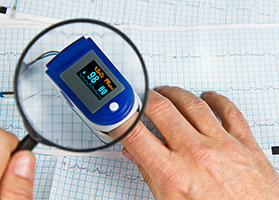 Sleep apnea has traditionally been extremely difficult to diagnose, monitor and treat.
Sleep apnea has traditionally been extremely difficult to diagnose, monitor and treat.
Whereas it’s important to know where you stand with your sleep apnea (whether you’ve been diagnosed already or not), who wants to spend several nights a year in sleep laboratory hooked up with wires?
The good news is that group of scientists got together and discovered the simplest and easiest way to monitor and diagnose sleep apnea.
And this leads to even simpler cure for the disease.
If you’ve been diagnosed officially with sleep apnea, you were probably hooked overnight with:
– Polysomnography involves an oximeter to record blood oxygen levels
– a brain activity monitor (EEG), a heartbeat recorder (ECG)
– a muscle tension measure, and an eye movement recorder
…all recorded and then manually analyzed.
No wonder so few people with sleep apnea get the diagnoses they need.
And even worse, if your sleep apnea gets better, there is no way to know (except going through that whole thing again).
But the scientists in question went over previous studies to collect the information of 4,191 people treated in 13 sleep laboratories from around the world.
What they discovered was that blood oxygen measurements were the only bits of data that were genuinely necessary, and that the rest of the polysomnography information was superfluous.
In addition, they saw that a computer could automatically analyze blood oxygen levels, and that manual analysis of results was unnecessary.
Therefore, sleep apnea can be diagnosed and through an automatic computer analysis of blood oxygen alone.
Luckily, a device that can measure this is already available. It is called a pulse oximeter and it attaches to your fingertip to monitor the amount of oxygen carried through your blood stream.
It automatically analyses the results and displays them. A reading of 90% or below is too low, while a reading of 95% or higher is considered normal.
You can buy one in most pharmacies or your doctor should be able to lend you one.
And this leads us to the best news…
If you can monitor your sleep apnea mostly on your own, you can use it to track your recovery curing the disease.

 Overcoming IBD
Overcoming IBD Multiple Sclerosis
Multiple Sclerosis Banishing Bronchitis
Banishing Bronchitis Gum Disease Gone
Gum Disease Gone Overcoming Onychomycosis
Overcoming Onychomycosis Neuropathy No More
Neuropathy No More The Prostate Protocol
The Prostate Protocol Brain Booster
Brain Booster
 Ironbound
Ironbound
 Solution for Shingles
Solution for Shingles
 The Bone Density Solution
The Bone Density Solution
 The Ultimate Healing Protocol
The Ultimate Healing Protocol
 The Parkinson's Protocol
The Parkinson's Protocol
 The Chronic Kidney Disease Solution
The Chronic Kidney Disease Solution
 Overthrowing Anxiety
Overthrowing Anxiety The Fatty Liver Solution
The Fatty Liver Solution The Hypothyroidism Solution
The Hypothyroidism Solution
 The End of Gout
The End of Gout The Blood Pressure Program
The Blood Pressure Program
 The Oxigized Cholesterol Strategy
The Oxigized Cholesterol Strategy
 Stop Snoring And Sleep Apnea Program
Stop Snoring And Sleep Apnea Program
 The Arthritis Strategy
The Arthritis Strategy The Vertigo & Dizziness Program
The Vertigo & Dizziness Program The 3-Step Diabetes Strategy
The 3-Step Diabetes Strategy Hemorrhoids Healing Protocol
Hemorrhoids Healing Protocol The Erectile Dysfunction Master
The Erectile Dysfunction Master Weight Loss Breeze
Weight Loss Breeze The IBS Program
The IBS Program The Insomnia Program
The Insomnia Program The Migraine and Headache Program
The Migraine and Headache Program The Neck Pain Solution
The Neck Pain Solution The Menopause Solution
The Menopause Solution The Ejaculation Master
The Ejaculation Master The TMJ Solution
The TMJ Solution The Acid Reflux Solution
The Acid Reflux Solution The Fibromyalgia Solution
The Fibromyalgia Solution The Psoriasis Strategy
The Psoriasis Strategy